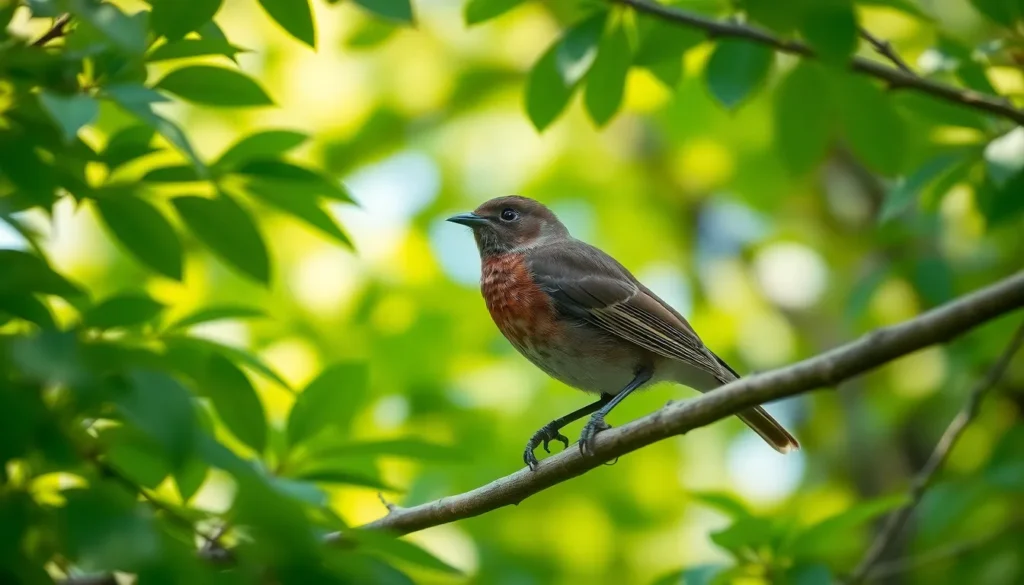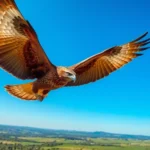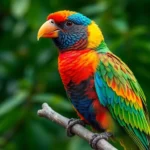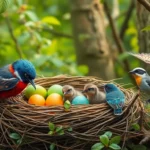We’ve all heard the phrase “singing like a nightingale” but few of us truly understand the remarkable bird behind this timeless expression. The nightingale’s legendary vocal abilities have inspired poets musicians and nature lovers for centuries yet this small brown songbird remains one of nature’s most mysterious performers.
What makes the nightingale so special? These incredible birds possess one of the most complex and beautiful songs in the animal kingdom with males capable of producing over 200 different phrases and melodies. Their powerful voices can carry for miles through forests and gardens creating an enchanting soundtrack that’s captivated humans since ancient times.
We’re about to dive deep into the intriguing area of nightingales exploring everything from their unique singing abilities and migration patterns to their cultural significance and conservation status. Whether you’re a bird enthusiast or simply curious about these legendary songsters you’ll discover why nightingales continue to hold such a special place in our hearts and folklore.
Physical Characteristics of the Nightingale Bird
The nightingale’s physical attributes perfectly complement their extraordinary singing abilities. These birds possess a compact yet elegant form that makes them instantly recognizable to ornithologists and bird watchers alike.
Size and Build
Nightingales measure 6.3 to 6.9 inches (16 to 17.5 centimeters) in length with a wingspan reaching 8.7 to 10.2 inches (22 to 26 centimeters). Adult birds typically weigh between 0.6 to 0.9 ounces (18 to 27 grams), making them slightly larger than common wrens but smaller than robins.
The species displays a robust build with a rounded head that supports their powerful vocal apparatus. Their bodies feature strong legs adapted for ground foraging and quick movements through dense vegetation. Males and females share identical physical dimensions, showing no important sexual dimorphism in size or structure.
Plumage and Coloration
Nightingales wear subdued earth tones that provide excellent camouflage in their woodland habitats. Their upperparts display rich rufous brown coloration that transitions to a warmer chestnut shade on the rump and tail feathers.
The underparts present pale buff to whitish coloring with subtle brown speckles across the throat and breast areas. Their wings show darker brown flight feathers with lighter brown coverts creating a mottled appearance. Young birds exhibit more pronounced spotting patterns that fade as they mature into adult plumage.
Both sexes maintain identical coloration patterns throughout the year, though breeding adults may show slightly more vibrant rufous tones during spring months.
Distinctive Features
Large dark eyes dominate the nightingale’s facial features, providing excellent vision for handling dense undergrowth during dawn and dusk activity periods. Their bills appear straight and pointed, measuring approximately 0.5 inches (1.3 centimeters) long, perfectly designed for capturing insects and small invertebrates.
The throat region shows specialized muscular development that supports their complex vocalizations, though this enhancement remains invisible externally. Their tails extend proportionally long compared to body size, featuring 12 graduated feathers that aid in agile maneuvering through thick vegetation.
Nightingales possess remarkably strong feet with sharp claws that enable secure perching on thin branches and effective ground scratching while foraging for food.
Habitat and Geographic Distribution
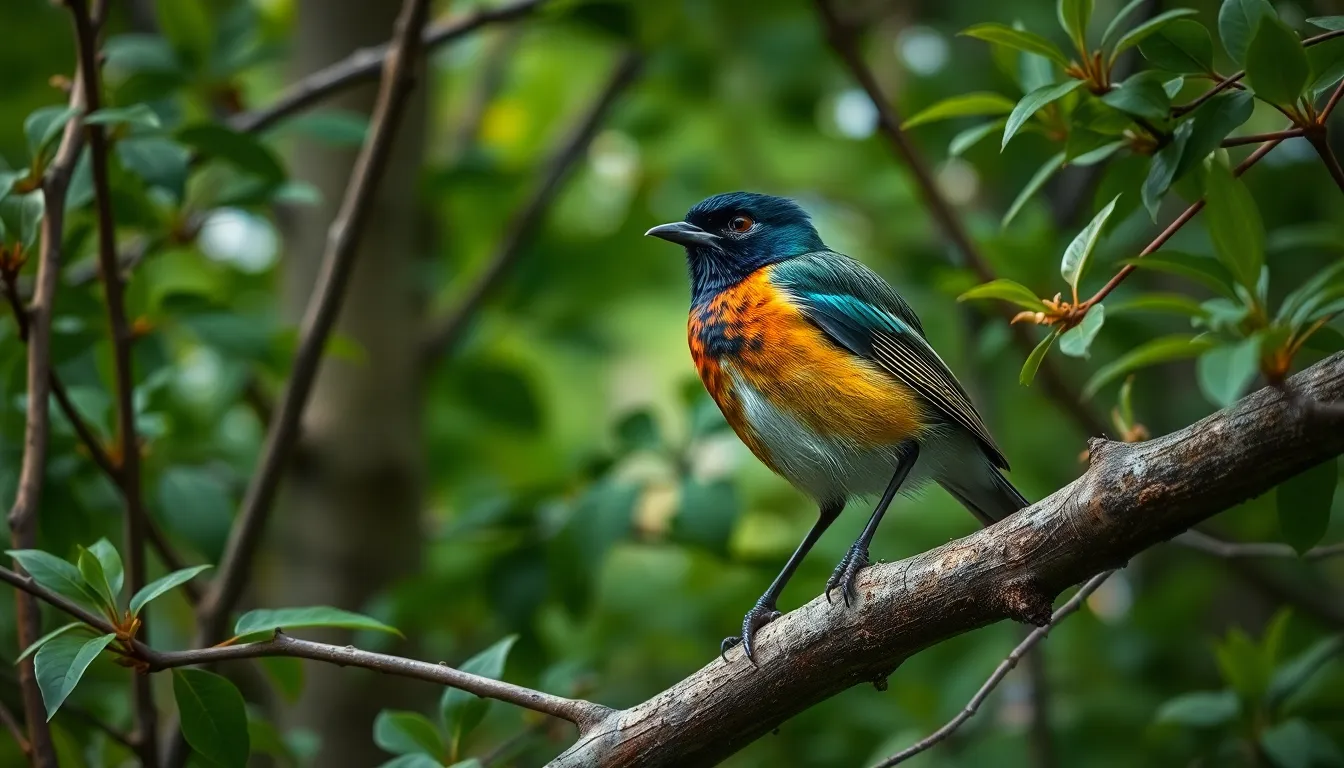
Nightingales demonstrate remarkable adaptability across diverse environments throughout their range. These birds occupy exact ecological niches that support their complex behavioral patterns and seasonal movements.
Natural Habitats
Nightingales thrive in dense woodlands with thick understory vegetation where they can forage and nest securely. Deciduous forests provide optimal conditions, particularly areas dominated by oak, birch, and hazel trees that create multilayered canopies. Scrubland environments attract these birds, especially locations with brambles, elderberry bushes, and wild rose thickets that offer both food sources and protective cover.
Riparian zones along rivers and streams serve as critical habitat corridors. Parks and large gardens within urban areas support nightingale populations when mature trees and dense shrubbery exist. Coppiced woodlands maintain ideal conditions through rotational management practices that create varying stages of vegetation growth.
| Habitat Type | Vegetation Requirements | Primary Use |
|---|---|---|
| Deciduous forests | Oak, birch, hazel canopy | Breeding and nesting |
| Scrubland | Brambles, elderberry, rose thickets | Foraging and shelter |
| Riparian zones | Dense riverside vegetation | Migration corridors |
| Urban parks | Mature trees with understory | Seasonal residence |
Migration Patterns
European nightingales undertake extensive migrations covering distances up to 6,000 miles between breeding and wintering grounds. Spring migration begins in late March, with birds arriving at European breeding sites between April and May. Peak migration occurs during optimal weather conditions when insects are abundant along flight routes.
Autumn departure starts in August, with most birds leaving European territories by September. Young birds migrate 2-3 weeks after adults, following established flyways through the Mediterranean region. Nightingales travel primarily at night, using celestial navigation and magnetic field detection to maintain accurate directional heading.
Stopover sites along migration routes provide essential refueling opportunities. Mediterranean islands, North African coastal areas, and river valleys serve as critical resting points where birds replenish energy reserves through intensive foraging.
Global Range
Common nightingales occupy breeding territories across Europe from southern Scandinavia to the Mediterranean basin. Their range extends eastward through Asia Minor, the Caucasus region, and into western Siberia. Populations exist in northwest Africa, including Morocco, Tunisia, and northern Algeria.
Wintering grounds cover tropical Africa from Senegal to Sudan and south to Kenya and Tanzania. Isolated populations breed in central Asia, with some reaching as far east as Mongolia and western China. British nightingale populations concentrate in southeast England, particularly in Kent, Surrey, and Essex counties.
Recent decades show range contractions in northern European countries including Denmark, Sweden, and parts of Germany. Climate change affects breeding success rates and shifts optimal habitat zones northward, altering traditional distribution patterns across the species’ range.
The Nightingale’s Famous Song

The nightingale’s song represents one of nature’s most sophisticated acoustic performances, combining power with intricate musical complexity. These remarkable birds produce melodies that captivate listeners across continents and inspire countless artistic works.
Vocal Abilities and Range
Male nightingales demonstrate extraordinary vocal versatility through their ability to produce over 200 distinct phrases and note combinations. Each bird develops a unique repertoire that includes whistles, trills, crescendos, and melodic sequences lasting 2 to 4 seconds. Their songs carry across distances of up to 1 mile in optimal conditions, with sound frequencies ranging from 1,000 to 8,000 Hz.
The specialized syrinx (vocal organ) enables nightingales to create multiple tones simultaneously, generating harmonic overlays that enhance song complexity. Male birds expand their vocal repertoires throughout their lives, with older individuals typically mastering 250 to 300 different musical phrases. Territory holders produce songs at volumes reaching 95 decibels measured from 3 feet away, comparable to urban traffic noise levels.
When and Why They Sing
Nightingales sing primarily during two distinct periods: the pre-dawn hours from 3:00 to 5:00 AM and throughout the night from dusk until midnight. Males begin their vocal displays immediately upon arriving at breeding territories in late April, continuing this behavior for 6 to 8 weeks during peak breeding season.
Territorial defense drives the majority of nightingale vocalizations, with males using songs to establish boundaries spanning 0.25 to 0.5 acres. Unmated males sing most frequently, producing up to 300 songs per hour during peak activity periods. Once pair bonding occurs, singing frequency decreases to 50 to 100 songs per hour, shifting focus from mate attraction to territory maintenance.
Environmental factors influence singing patterns significantly, with optimal conditions occurring during calm nights with temperatures between 50°F and 70°F. Rain and strong winds reduce vocal activity by 60 to 80%, while moonlit nights often increase singing duration and intensity.
Song Variations
Individual nightingales develop signature song patterns that remain consistent across multiple breeding seasons. Regional dialects emerge within populations separated by 50 to 100 miles, creating distinct musical traditions passed between generations through vocal learning.
Young males acquire song components by listening to adult tutors during their first year, incorporating 70 to 80% of local phrase variations into their developing repertoires. Cultural transmission occurs through direct interaction, with juvenile birds learning 15 to 25 new phrases from each adult mentor they encounter.
Geographic variations include Mediterranean nightingales producing faster-paced songs with 20% more rapid note transitions compared to northern European populations. Eastern European birds incorporate distinctive rolling trills lasting 3 to 5 seconds, while western populations emphasize clear whistle sequences and melodic progressions. Urban nightingales adapt their vocalizations by increasing volume 10 to 15 decibels and shifting to higher frequencies to overcome ambient noise pollution.
Behavior and Lifestyle
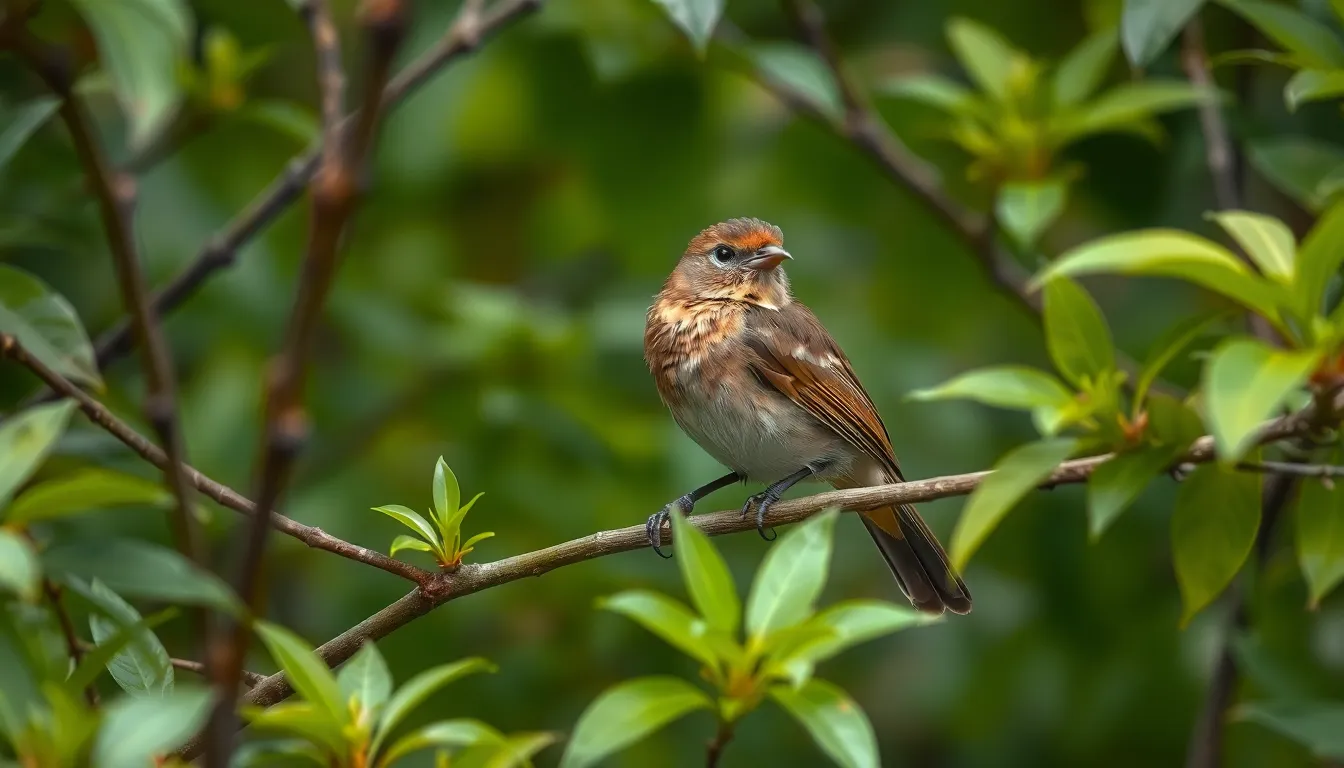
Nightingale birds exhibit complex behavioral patterns that reflect their adaptability and evolutionary success across diverse environments. Their daily activities revolve around foraging, territorial maintenance, and reproductive behaviors that vary seasonally.
Feeding Habits
Nightingales demonstrate opportunistic feeding strategies that adapt to seasonal food availability and habitat conditions. These birds primarily consume insects during breeding season, with beetles, caterpillars, ants, and flies comprising 85% of their diet from April through August. Ground foraging represents their preferred hunting method, using their strong legs to scratch through leaf litter and probe soil crevices.
Fruit consumption increases dramatically during late summer and autumn months, providing essential energy reserves for migration. Blackberries, elderberries, and rowan berries constitute their primary plant food sources, with individual birds consuming up to 30 berries per hour during peak feeding periods.
| Food Type | Breeding Season % | Migration Season % | Primary Sources |
|---|---|---|---|
| Insects | 85% | 40% | Beetles, caterpillars, ants |
| Berries | 10% | 55% | Blackberries, elderberries |
| Seeds | 5% | 5% | Grass seeds, small nuts |
Urban nightingales modify their foraging behaviors to exploit human-provided resources, visiting garden bird tables and compost heaps where insects concentrate. Dawn and dusk represent peak foraging periods when insects are most active and accessible.
Nesting and Breeding
Breeding nightingales establish territories measuring 0.5 to 2 acres in size during their April arrival at breeding grounds. Male birds arrive 7 to 10 days before females and immediately begin singing to claim territory and attract mates. Territory boundaries often overlap in high-quality habitats where multiple pairs nest within 100 meters of each other.
Nest construction occurs exclusively by females over a 3 to 5 day period in dense vegetation 1 to 6 feet above ground level. The cup-shaped structure consists of dead leaves, moss, and grass lined with fine roots and hair, measuring approximately 4 inches in diameter. Preferred nesting sites include bramble thickets, young coppice growth, and shrub undergrowth that provides concealment from predators.
Egg laying begins in early May with clutches containing 4 to 5 olive-brown eggs measuring 20mm in length. Incubation lasts 13 to 14 days with females spending 65% of daylight hours on the nest. Males contribute to territory defense and predator alarm calls but don’t participate in incubation duties.
Fledgling development requires 11 to 12 days in the nest followed by an additional 14 to 16 days of parental care after leaving the nest. Parents continue feeding juveniles insects at rates of 8 to 12 feeds per hour during the first week post-fledging. Second broods occur in 40% of successful pairs when environmental conditions remain favorable through July.
Social Behavior
Nightingales exhibit predominantly solitary behavior outside the breeding season with limited social interactions between individuals. Territorial males engage in aggressive displays including wing flicking, tail spreading, and intense singing competitions when boundaries are challenged. Physical confrontations remain rare, occurring in fewer than 5% of territorial disputes.
Migration occurs in loose flocks of 10 to 30 individuals that form temporary associations during river crossings and desert passages. These groups don’t maintain cohesive social structures but benefit from collective vigilance against predators during vulnerable crossing periods.
Communication extends beyond song to include alarm calls, contact notes, and aggressive vocalizations that serve different behavioral functions. Alarm calls consist of harsh “tack-tack” sounds repeated 4 to 6 times when predators approach nesting areas. Contact calls between paired birds feature soft whistling notes used to maintain proximity during foraging activities.
Roosting behavior varies seasonally with breeding birds sleeping individually in dense cover while migrants form communal roosts of 50 to 200 individuals in reed beds and scrubland. These temporary aggregations provide safety in numbers during the vulnerable migration period when energy reserves are depleted and predation risk increases.
Species and Subspecies
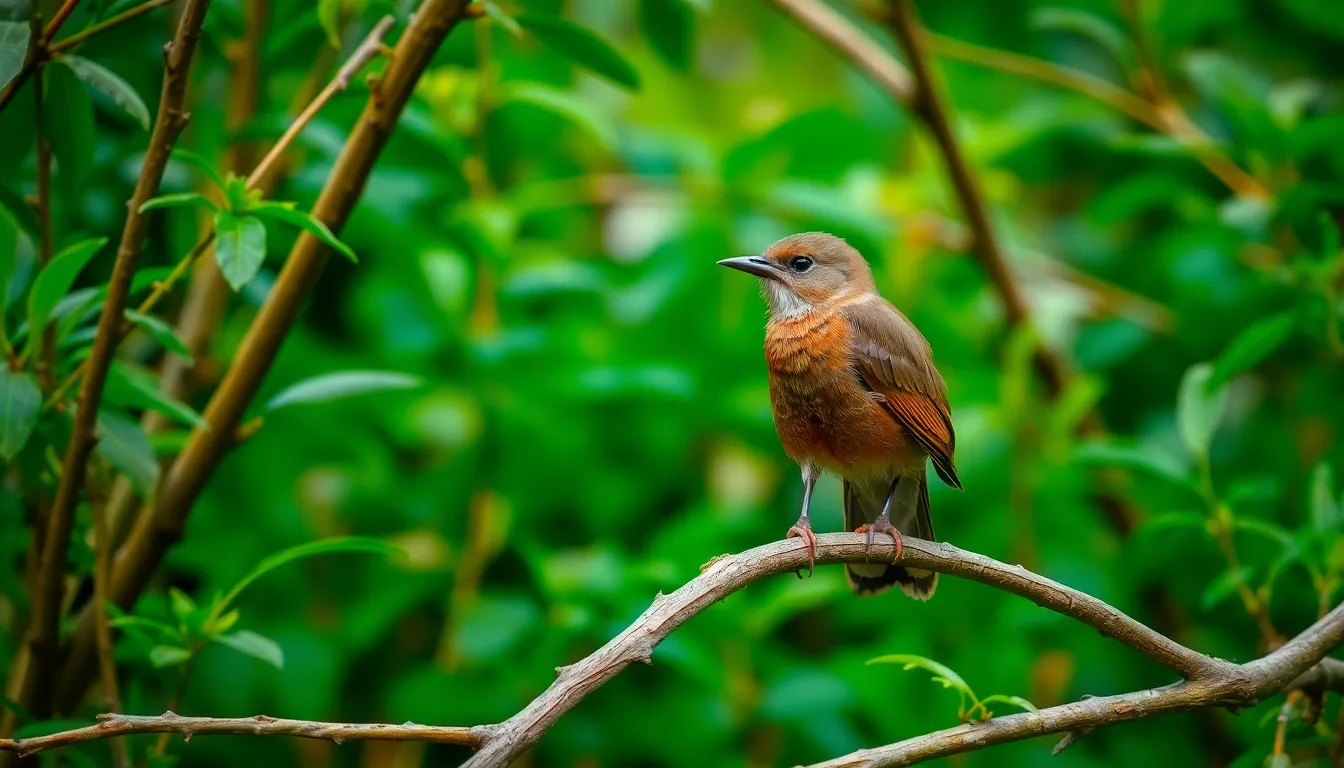
Two distinct nightingale species dominate global bird classification systems. Taxonomists recognize these species based on genetic analysis and morphological differences that affect singing patterns and geographic distribution.
Common Nightingale
Common nightingales (Luscinia megarhynchos) represent the most widespread species across Europe and western Asia. These birds measure 6.5 inches in length and display uniform brown plumage with lighter underparts that provide excellent camouflage in dense vegetation.
Four recognized subspecies of common nightingales exist across different geographic regions:
- L. m. megarhynchos – Western and central European populations
- L. m. africana – Iberian Peninsula and North African breeding grounds
- L. m. golzii – Eastern European and western Asian territories
- L. m. hafizi – Iranian and Caucasus mountain regions
Genetic studies indicate common nightingales diverged from other Luscinia species approximately 2.3 million years ago. Males produce songs containing 180 to 260 different phrases with frequencies ranging from 1,000 to 6,000 hertz.
Thrush Nightingale
Thrush nightingales (Luscinia luscinia) occupy northern and eastern European ranges extending into Siberia. These birds appear larger than common nightingales at 6.7 inches in length and exhibit more pronounced spotting on their breast feathers.
Distribution patterns show thrush nightingales breeding in:
| Region | Breeding Range | Population Estimate |
|---|---|---|
| Scandinavia | Norway, Sweden, Finland | 450,000 pairs |
| Baltic States | Estonia, Latvia, Lithuania | 180,000 pairs |
| Eastern Europe | Poland, Belarus, Ukraine | 320,000 pairs |
| Russia | Western Siberia | 280,000 pairs |
Thrush nightingales demonstrate different vocal characteristics compared to their common counterparts. Males incorporate deeper tones and longer pauses between phrases. Song repertoires contain 120 to 200 distinct elements with emphasis on liquid notes and churring sounds.
Regional Variations
Geographic isolation has produced notable subspecies variations within both nightingale species. Common nightingales in Mediterranean regions exhibit darker plumage and slightly smaller body sizes compared to northern European populations.
Eastern subspecies of common nightingales display:
- Extended tail feathers measuring 2.8 inches versus 2.5 inches in western birds
- Increased bill length for capturing different insect prey
- Modified song structures incorporating regional dialect patterns
Thrush nightingales show less subspecies variation due to their more recent evolutionary divergence. Scandinavian populations maintain slightly larger body proportions while Siberian birds develop thicker plumage for harsh winter conditions during migration preparation.
Climate change impacts affect subspecies distribution patterns across Europe. Northern populations of both species have shifted breeding ranges 47 miles northward over the past three decades. Southern subspecies face habitat compression as Mediterranean regions experience increased temperatures and reduced precipitation levels.
Cultural Significance and Symbolism
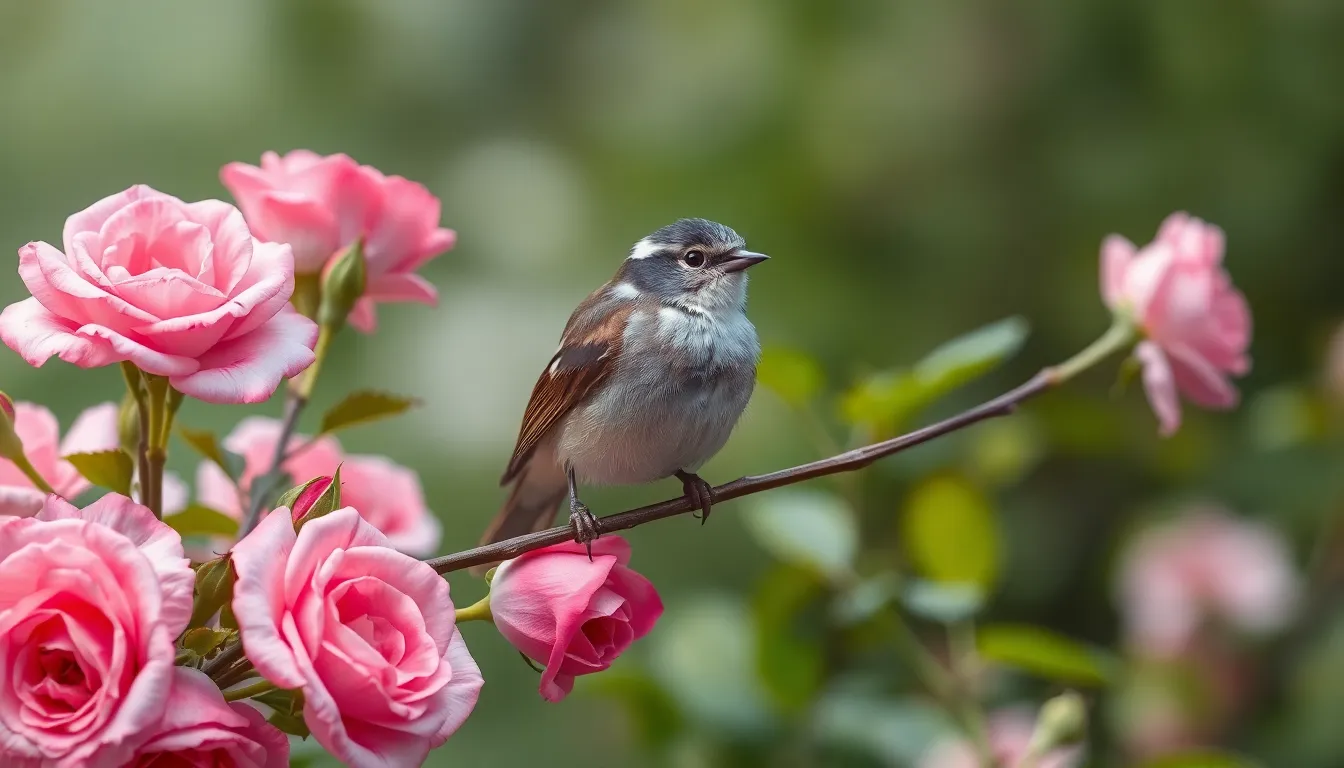
Nightingales hold an extraordinary place in human culture across civilizations. Their haunting melodies have shaped literature, music, and mythology for thousands of years.
Literary References
Shakespeare immortalized the nightingale in “Romeo and Juliet” when Juliet mistakes its song for the lark at dawn. John Keats composed his famous “Ode to a Nightingale” in 1819, exploring themes of mortality and transcendence through the bird’s eternal song. Oscar Wilde crafted “The Nightingale and the Rose” as a poignant tale of sacrifice and unrequited love.
Persian poetry features nightingales prominently in the works of Hafez and Rumi, where the birds symbolize divine love and spiritual longing. Hans Christian Andersen’s “The Nightingale” contrasts natural beauty with artificial creation in his 1843 fairy tale. Contemporary authors continue referencing nightingales as symbols of artistic inspiration and natural wonder.
T.S. Eliot incorporated nightingale imagery in “The Waste Land” to represent lost beauty and cultural decay. Christina Rossetti used nightingale metaphors in her romantic poetry to express deep emotional states. These literary traditions establish the nightingale as a universal symbol of artistic expression.
Musical Inspiration
Classical composers have drawn inspiration from nightingale songs for centuries of musical creation. Respighi’s “Pines of Rome” incorporates actual nightingale recordings in its famous villa section. Handel composed “Sweet Bird” featuring elaborate vocal ornamentations mimicking nightingale melodies.
Vivaldi’s “The Four Seasons” includes nightingale imitations in its spring concerto movements. Beethoven incorporated birdsong motifs resembling nightingales in his Sixth Symphony’s pastoral scenes. Modern composers like Messiaen studied actual nightingale songs to create precise musical transcriptions.
Folk music traditions across Europe feature nightingales as romantic symbols in countless ballads. Russian composers including Rimsky-Korsakov used nightingale themes in orchestral works and operas. Jazz musicians have adapted nightingale-inspired melodies into contemporary arrangements.
Electronic music producers now sample actual nightingale recordings for ambient and nature-based compositions. Opera singers train to mimic nightingale vocal techniques for coloratura passages. Film composers frequently use nightingale motifs to evoke romantic or melancholic atmospheres.
Folklore and Mythology
Ancient Greek mythology associates nightingales with the tragic story of Philomela, transformed into the bird after experiencing violence. Roman folklore connected nightingales to love poetry and passionate expression. Norse mythology linked nightingales to messages from the spirit industry.
Chinese culture views nightingales as symbols of romantic love and marital harmony. Japanese traditions associate nightingales with spring renewal and poetic inspiration. Persian folklore depicts nightingales as lovers eternally singing to roses.
European folk beliefs claim nightingales sing with human souls of departed lovers. Medieval Christianity connected nightingale songs to divine praise and spiritual devotion. Slavic traditions suggest nightingales carry messages between lovers separated by distance.
| Cultural Tradition | Symbolic Meaning | Notable Examples |
|---|---|---|
| Greek Mythology | Transformation, tragedy | Philomela legend |
| Persian Literature | Divine love, spiritual longing | Works of Hafez |
| European Folklore | Romantic messages | Folk ballads |
| Christian Symbolism | Divine praise | Medieval hymns |
| Asian Traditions | Marital harmony | Chinese poetry |
Indigenous European cultures believed nightingales possessed prophetic abilities about weather and seasonal changes. Gypsy folklore attributes magical healing properties to nightingale songs. Modern cultural movements continue incorporating nightingale symbolism in environmental and artistic contexts.
Conservation Status and Threats
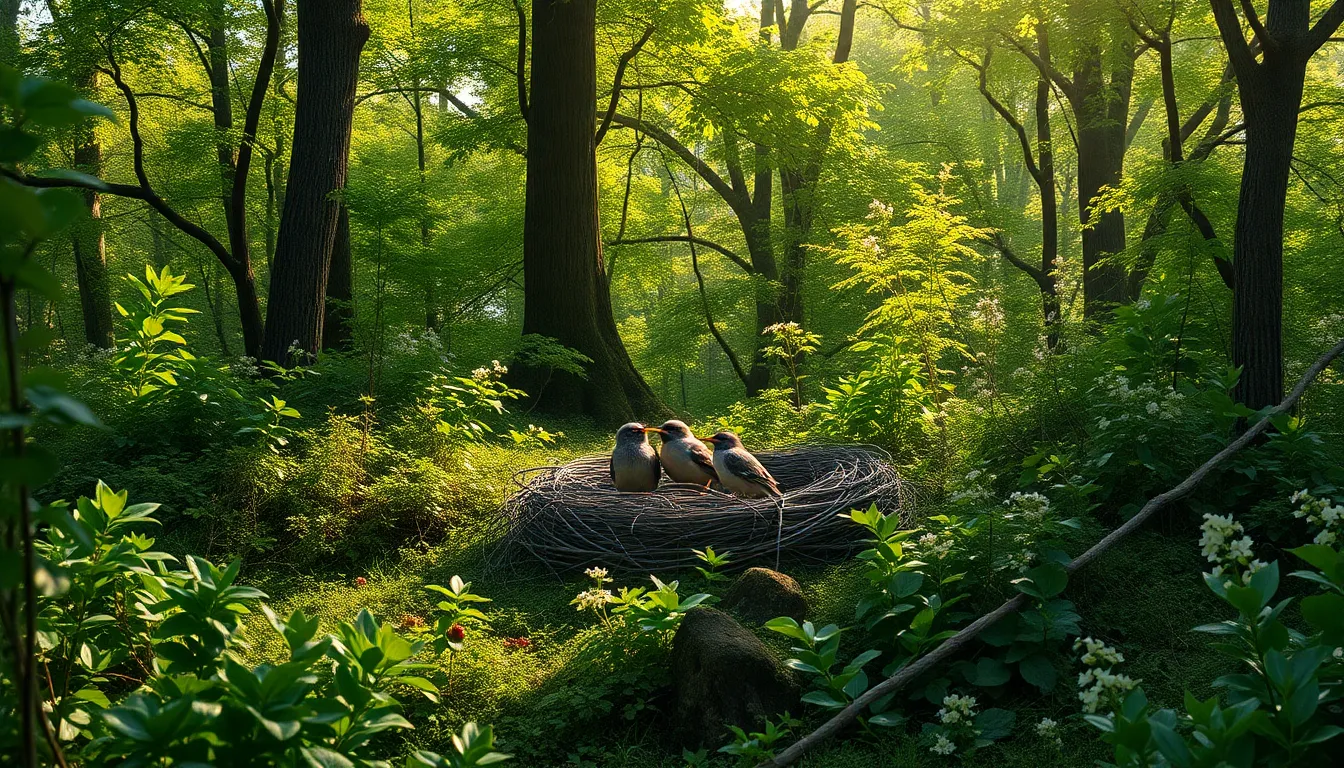
Nightingale populations face mounting pressures across their traditional ranges. Current conservation assessments reveal concerning trends that demand immediate attention from wildlife organizations and governments.
Population Trends
European nightingale populations have declined by 43% since 1980 according to the European Bird Census Council. Common nightingales show the steepest decreases in northern European countries including the United Kingdom, Netherlands, and Denmark. Population monitoring data from 2010 to 2020 indicates annual decline rates of 2.8% in breeding territories across 15 European nations.
Thrush nightingale populations remain more stable in Scandinavia and eastern Europe, with only minor fluctuations recorded over the past decade. Regional variations exist within species ranges, as Mediterranean populations maintain relatively steady numbers while northern populations contract southward. Breeding pair estimates for common nightingales dropped from 6.2 million pairs in 1980 to 3.5 million pairs in 2020 across their European range.
Environmental Challenges
Agricultural intensification eliminates the dense understory vegetation nightingales require for nesting and foraging. Modern farming practices reduce insect populations by up to 75% in areas where nightingales traditionally breed. Climate change alters migration timing, creating mismatches between peak food availability and arrival dates at breeding grounds.
Urban development fragments woodland habitats, forcing nightingale populations into increasingly isolated patches. Light pollution disrupts their natural singing patterns and interferes with nocturnal foraging behaviors. Pesticide applications in agricultural areas reduce invertebrate prey species that comprise 80% of nightingale diets during breeding season.
Habitat degradation affects stopover sites along migration routes, with Mediterranean coastal areas experiencing particularly severe development pressures. Drought conditions in African wintering grounds reduce food availability and increase mortality rates during non-breeding periods.
Conservation Efforts
Protected area designations cover approximately 35% of known nightingale breeding territories across Europe. Wildlife management programs focus on maintaining dense scrubland habitats through controlled cutting rotations every 8 to 12 years. Agri-environment schemes provide financial incentives for farmers to preserve hedgerows and field margins essential for nightingale survival.
Research initiatives track nightingale movements using lightweight GPS tags weighing less than 0.6 grams. International cooperation agreements between European and African nations address habitat protection along entire migration corridors. Captive breeding programs operate in specialized facilities, though reintroduction efforts remain experimental.
Public awareness campaigns educate landowners about nightingale habitat requirements and encourage garden management practices that support local populations. Citizen science projects collect distribution data through smartphone applications, contributing to population monitoring efforts across 28 countries.
Observing Nightingales in the Wild
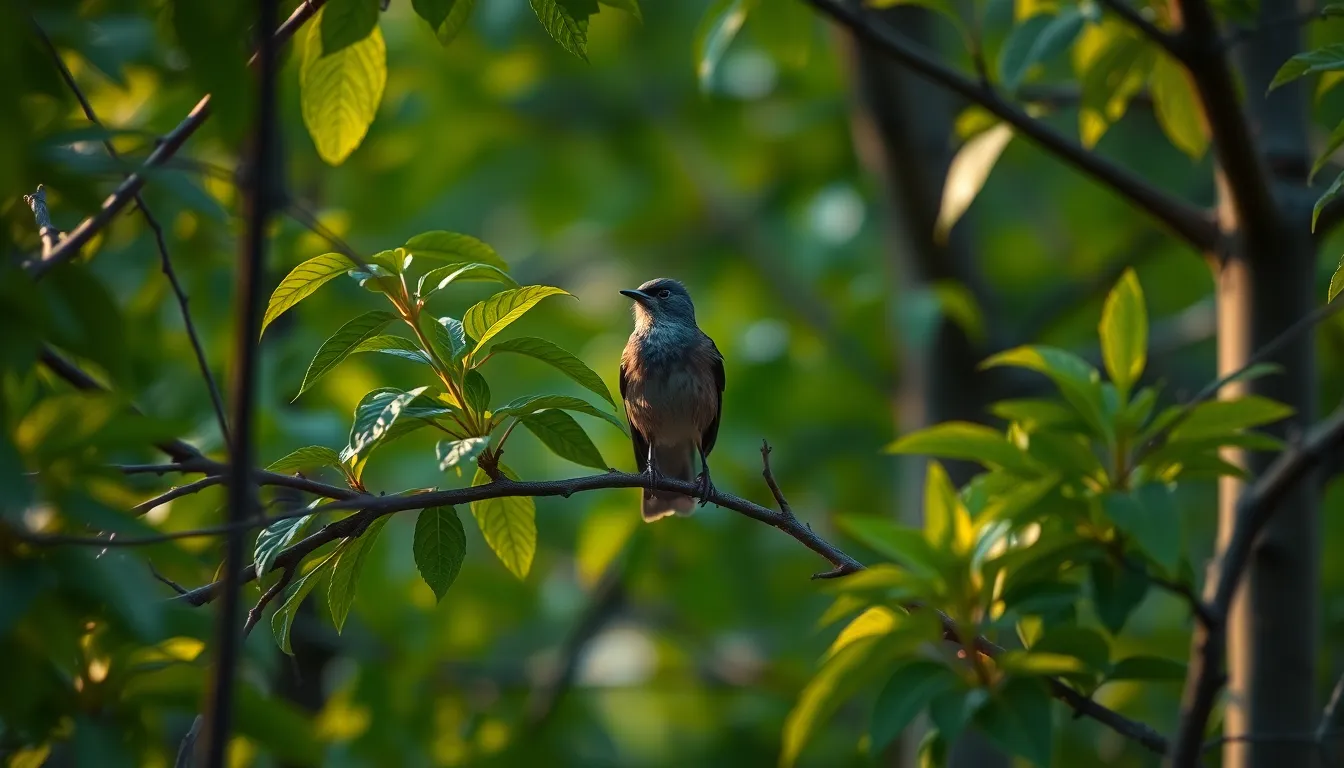
Observing nightingales in their natural habitat offers birdwatchers an extraordinary opportunity to witness one of nature’s most accomplished vocalists. These secretive birds require patience and strategic timing to locate successfully in the wild.
Best Times and Locations
Dawn provides the optimal window for nightingale observation, particularly between 4:00 AM and 6:00 AM when males deliver their most intense vocal performances. Evening hours from 8:00 PM to midnight also present excellent listening opportunities as territorial males establish their boundaries through song.
Dense woodland edges offer prime nightingale habitat, specifically areas where mature forest meets open clearings or water sources. Riparian zones along rivers and streams attract these birds consistently throughout the breeding season from April to July. Scrubland areas with thick understory vegetation provide ideal nesting sites and foraging grounds.
European locations deliver the most reliable nightingale encounters, with southern England’s Surrey Hills, Kent’s ancient woodlands, and France’s Loire Valley supporting stable populations. Mediterranean regions including Spain’s Andalusia and Italy’s Tuscany host nightingales from March through September. Migration hotspots such as Gibraltar and Cyprus offer spectacular viewing opportunities during spring and autumn passage periods.
Urban parks with mature trees and dense shrubbery surprisingly support nightingale populations in cities across their range. London’s Richmond Park, Berlin’s Tiergarten, and Vienna’s Schönbrunn Palace gardens maintain documented breeding pairs even though urban pressures.
Identification Tips
Physical appearance distinguishes nightingales through their modest brown plumage with slightly rufous tail feathers and pale buff underparts. Males and females share identical coloration patterns, measuring 6.3 to 6.9 inches in length with robust builds adapted for ground foraging.
Behavioral cues provide more reliable identification markers than visual features alone. Nightingales frequently cock their tails upward while perched and demonstrate characteristic ground hopping movements when foraging through leaf litter. Secretive nature keeps these birds hidden within dense vegetation most daylight hours.
Song structure offers the most definitive identification method, featuring complex phrases lasting 2 to 4 seconds with distinctive crescendos and liquid notes. Regional dialects emerge within populations, creating signature phrase combinations unique to exact territories.
Habitat preferences narrow identification possibilities significantly, as nightingales rarely venture into open areas or coniferous forests. Dense deciduous woodland understory, bramble thickets, and overgrown hedgerows indicate suitable nightingale territory.
Recording Their Songs
Digital recording equipment captures nightingale vocalizations effectively using directional microphones positioned 15 to 25 feet from singing perches. Early morning sessions between 4:30 AM and 5:30 AM yield the highest quality recordings with minimal background interference.
Sound analysis software reveals intricate details within nightingale songs, including frequency ranges extending from 1,000 Hz to 8,000 Hz across their vocal repertoire. Spectrogram analysis displays visual representations of phrase structures and helps identify individual birds through unique vocal signatures.
Recording techniques require patience and persistence, as individual males cycle through multiple phrase types before repeating patterns. Sessions lasting 30 to 45 minutes capture comprehensive samples of territorial songs and brief alarm calls.
Ethical considerations guide recording practices, maintaining respectful distances to avoid disrupting breeding behaviors or causing territorial displacement. Playback restrictions apply during sensitive nesting periods from May through July to prevent nest abandonment.
Conclusion
The nightingale stands as one of nature’s most extraordinary vocalists deserving our admiration and protection. We’ve witnessed how these remarkable birds combine scientific wonder with cultural significance creating a bridge between the natural industry and human creativity.
Their declining populations remind us that we’re at a critical moment for conservation action. By supporting habitat protection initiatives and raising awareness about their challenges we can help ensure future generations experience the magic of nightingale songs.
Whether you’re drawn to their complex melodies or inspired by their literary symbolism nightingales offer us profound lessons about resilience adaptation and the power of voice. We encourage you to seek out these incredible birds and become part of the community working to preserve their legacy for years to come.
Frequently Asked Questions
What makes nightingale songs so special and complex?
Nightingales are renowned for their extraordinary vocal abilities, with males capable of producing over 200 different phrases and melodies. Their songs combine whistles, trills, and crescendos, lasting 2-4 seconds and carrying up to 1 mile. They possess a specialized vocal organ that allows them to create multiple tones simultaneously, with older males mastering up to 300 different musical phrases.
How far do nightingales migrate and where do they travel?
European nightingales undertake extensive migrations of up to 6,000 miles between their breeding and wintering grounds. They travel from breeding areas in southern Scandinavia and the Mediterranean basin to wintering locations in Africa and parts of Asia. During migration, they rely on crucial stopover sites for refueling during these long journeys.
What are the main differences between Common Nightingales and Thrush Nightingales?
The two main species are the Common Nightingale, which is more widespread across Europe and western Asia with four recognized subspecies, and the Thrush Nightingale, found in northern and eastern Europe. They differ in geographic distribution, vocal characteristics, and some morphological features, though both share similar habitat preferences and behaviors.
When and where is the best time to observe nightingales?
The optimal times for observing nightingales are during pre-dawn hours and evening, particularly in dense woodlands, scrublands, riparian zones, and urban parks. They’re most active during the breeding season from April to July. Look for them in areas with thick vegetation where they forage on the ground and build their nests.
What are the biggest threats to nightingale populations?
Nightingale populations have declined by 43% since 1980, primarily due to agricultural intensification, climate change, and urban development. Habitat loss, particularly of dense woodland areas and stopover sites along migration routes, poses the greatest threat. Northern European populations are especially vulnerable, with ranges contracting due to environmental changes.
How do young nightingales learn their complex songs?
Young male nightingales learn their songs from adult tutors, incorporating local phrase variations into their repertoires. This creates regional dialects within populations, with distinct musical traditions emerging in different areas. The learning process involves mimicking and adapting the complex vocal patterns of experienced males in their territory.
What do nightingales eat and how do their diets change seasonally?
Nightingales exhibit opportunistic feeding strategies, primarily consuming insects during the breeding season when protein needs are highest. In late summer and autumn, they increase their intake of berries and fruits to build fat reserves for migration. Their diet adaptation helps them meet the energy demands of their different life stages.
Why are nightingales significant in literature and culture?
Nightingales have inspired artists and writers for thousands of years due to their haunting melodies and nocturnal singing habits. They appear in works by Shakespeare, Keats, Persian poets like Hafez and Rumi, and have influenced classical composers like Respighi and Handel. They symbolize themes of love, transformation, artistic expression, and spiritual longing across cultures.

